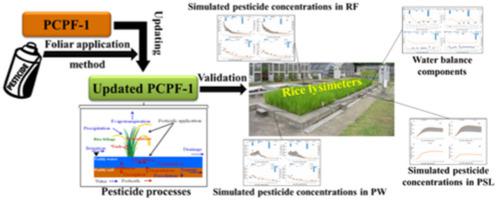Journal of Environmental Management ( IF 8.7 ) Pub Date : 2020-09-17 , DOI: 10.1016/j.jenvman.2020.111356 Le Hoang Tu 1 , Julien Boulange 2 , Thai Khanh Phong 3 , Dang Quoc Thuyet 4 , Hirozumi Watanabe 5 , Kazuhiro Takagi 6

|
The Pesticide Concentration in Paddy Field (PCPF-1) model has been successfully used to predict the fate and transport of granular pesticides applied to the paddy fields. However, it is not applicable for pesticides in foliar formulation while previous studies have reported that foliar application may increase the risks of rice pesticide contamination to the aquatic environment due to pesticide wash-off from rice foliage. In this study, we developed and added a foliar application module into the PCPF-1 model to improve its versatility regarding pesticide application methods. In addition, some processes of the original model such as photodegradation were simplified. The updated model was then validated with data from previous studies. Critical parameters of the model were calibrated using the Sequential Uncertainty Fitting version 2 (SUFI-2) algorithm. The calibrated model simulated pesticide dissipation trend and concentrations with moderate accuracy in the two paddy compartments including rice foliage and paddy water. The accuracy of the predicted soil concentrations could not be evaluated since no observed data were available. Although the p-factor and r-factor obtained using the SUFI2 algorithm indicated that the uncertainty encompassed in the predicted concentrations was rather high, the daily predicted pesticide concentrations in rice foliage and paddy water were satisfactory based on the NSE values (0.36–0.89). The updated PCPF-1 model is a flexible tool for the environmental risk assessment of pesticide losses and the evaluation of agricultural management practices for mitigating pesticide pollution associated with rice production.
中文翻译:

通过更新的PCPF-1模型预测稻叶施用后水稻农药的命运和运输。
稻田中的农药浓度(PCPF-1)模型已成功用于预测应用于稻田的粒状农药的运移情况。但是,它不适用于叶面制剂中的农药,而先前的研究已经报道,由于从叶面冲洗掉农药,叶面施用可能会增加水稻农药污染水生环境的风险。在这项研究中,我们开发了叶面施用模块并将其添加到PCPF-1模型中,以提高其在农药施用方法方面的多功能性。另外,简化了原始模型的某些过程,例如光降解。然后,使用来自先前研究的数据验证更新后的模型。使用顺序不确定性拟合第2版(SUFI-2)算法对模型的关键参数进行了校准。校准后的模型以中等精度模拟了两个稻谷区(包括稻叶和稻田水)中的农药消散趋势和浓度。由于没有可用的观测数据,因此无法评估预测的土壤浓度的准确性。尽管使用SUFI2算法获得的p因子和r因子表明预测浓度中包含的不确定性相当高,但基于NSE值(0.36-0.89),水稻叶面和稻田水中的每日预测农药浓度仍令人满意。



























 京公网安备 11010802027423号
京公网安备 11010802027423号